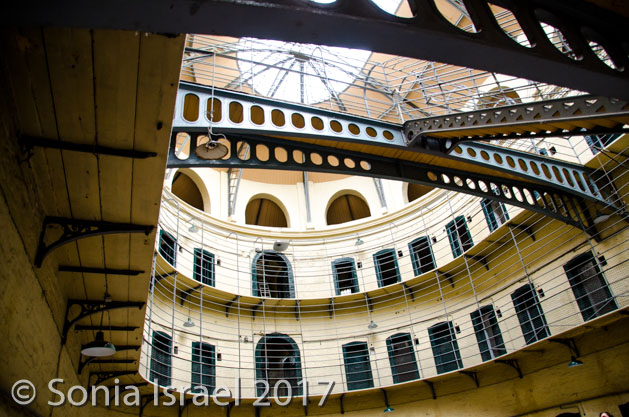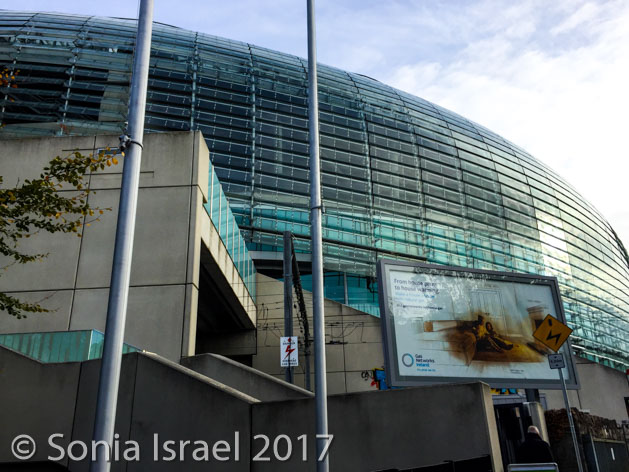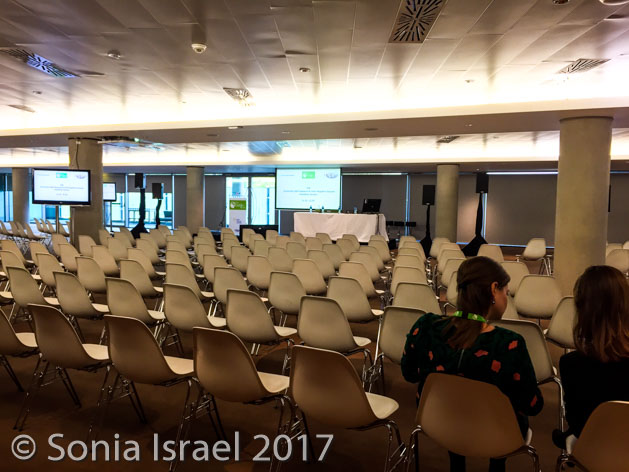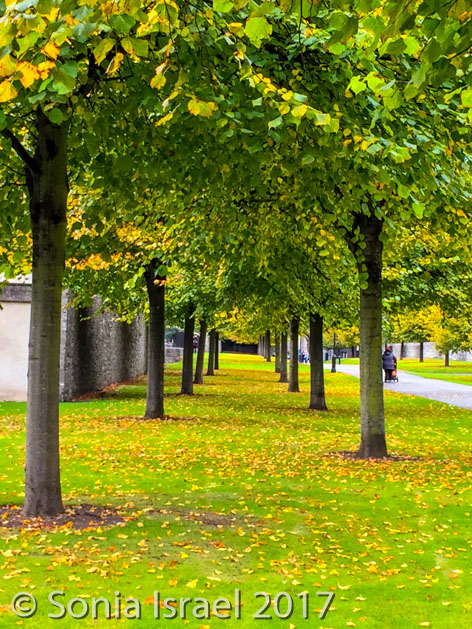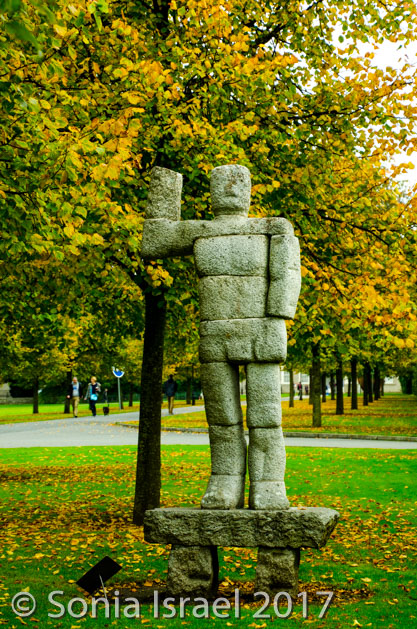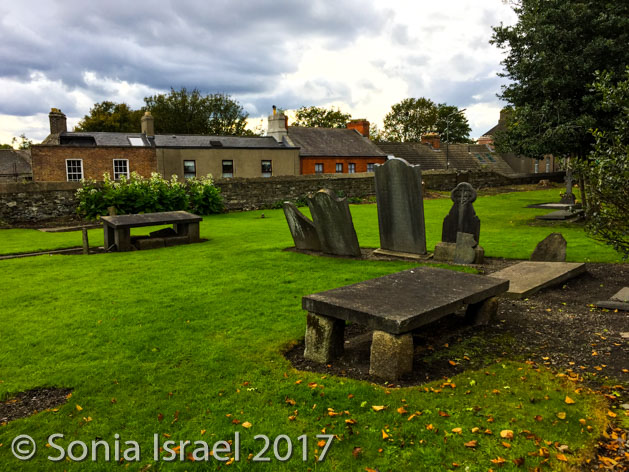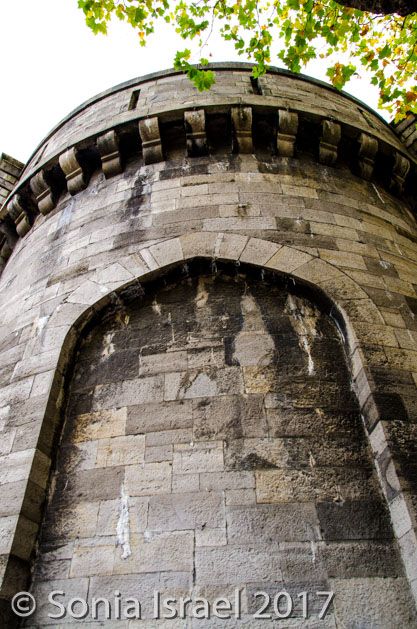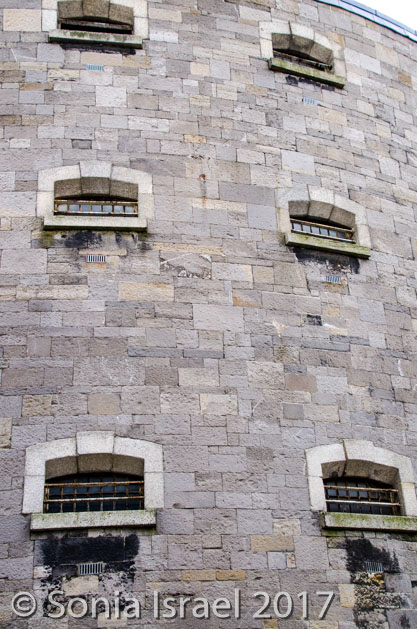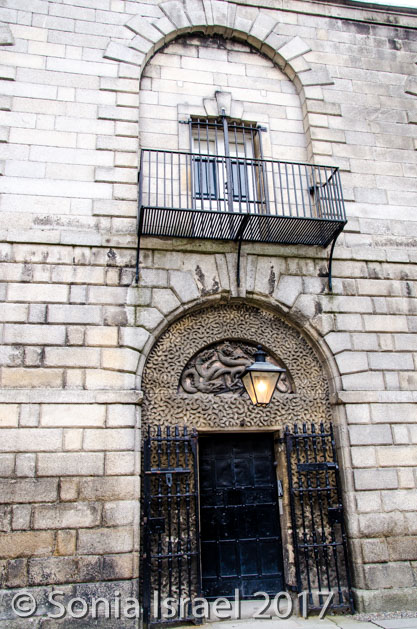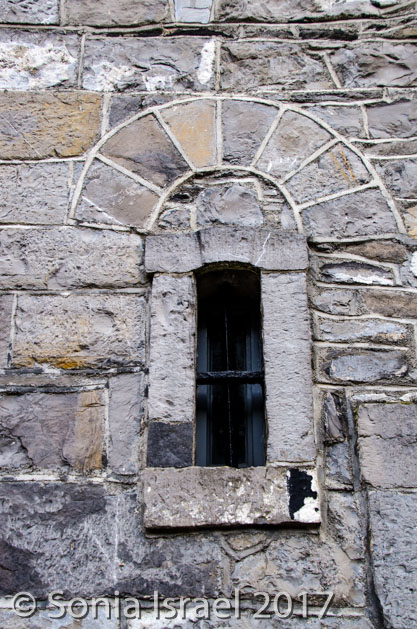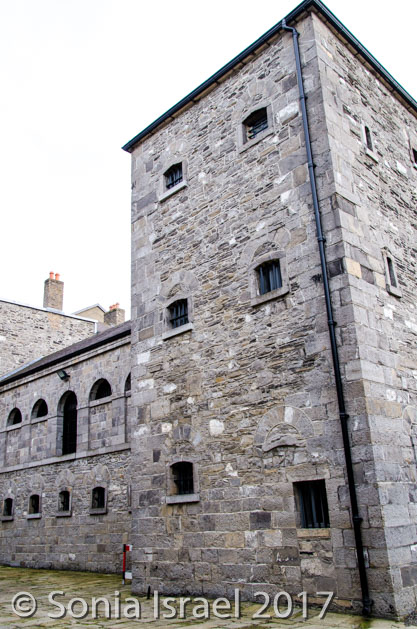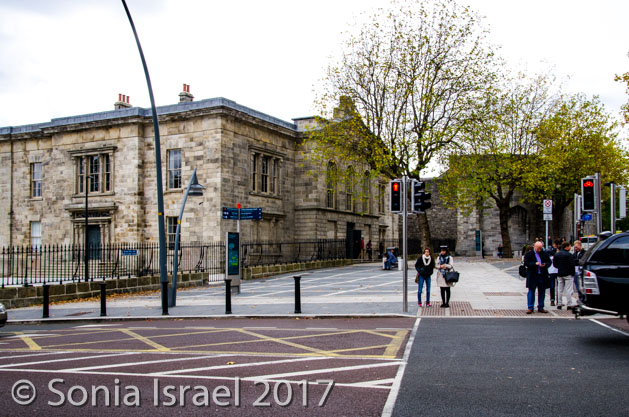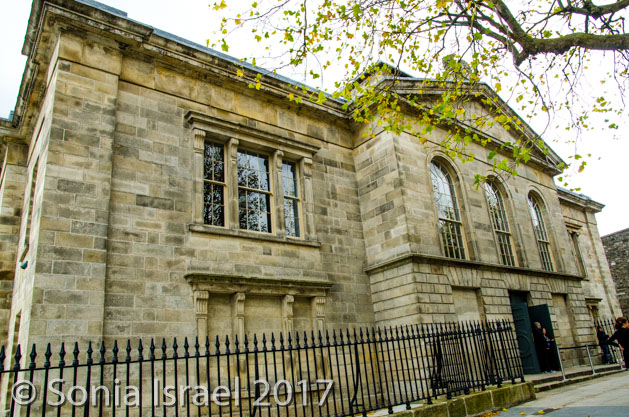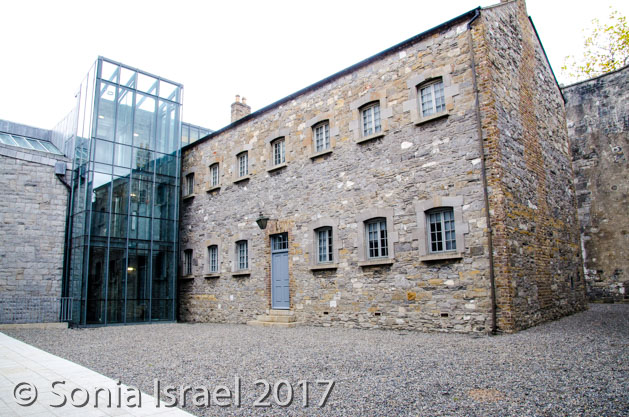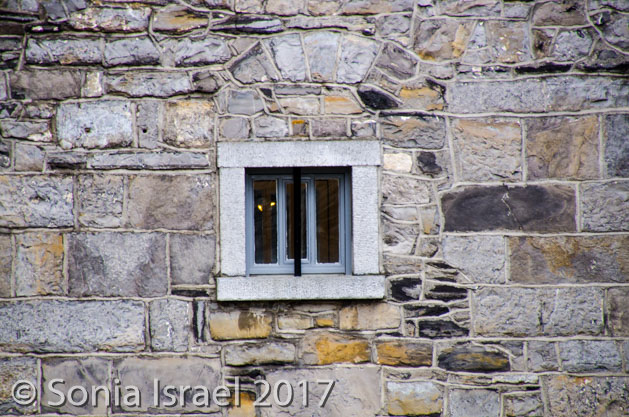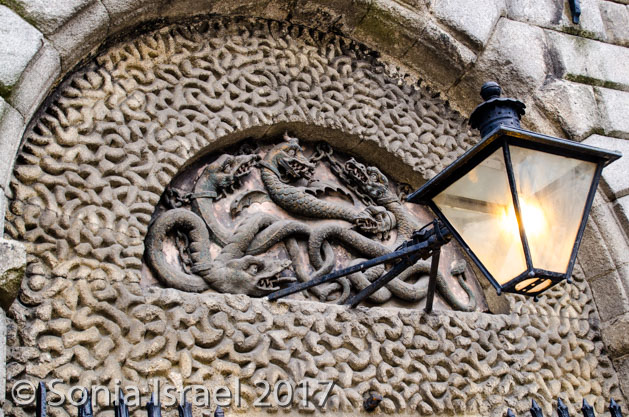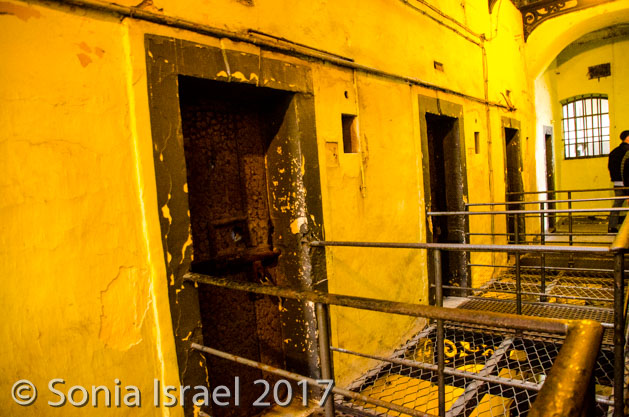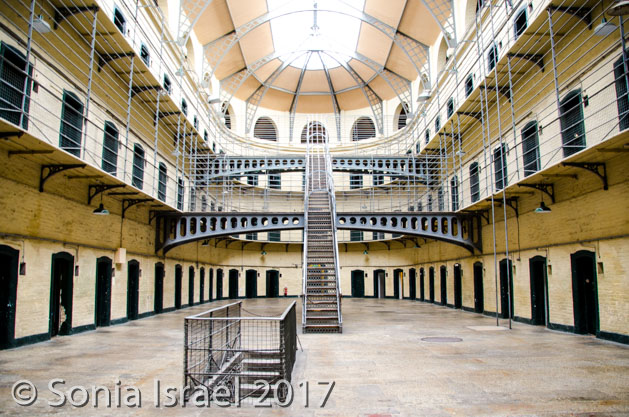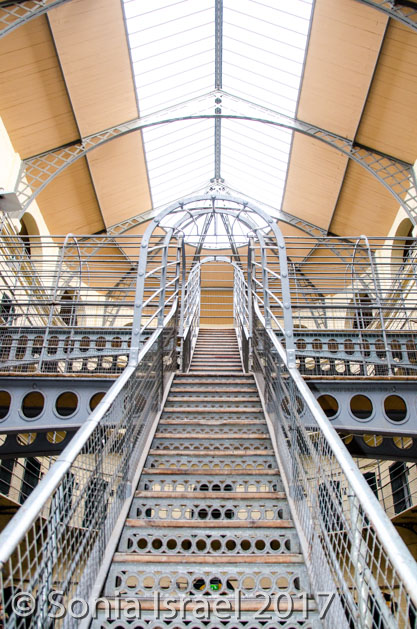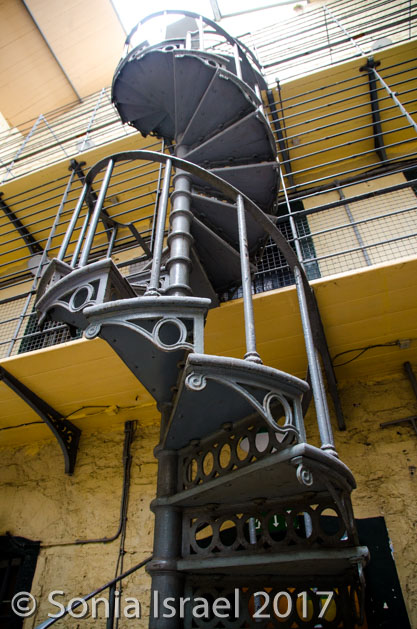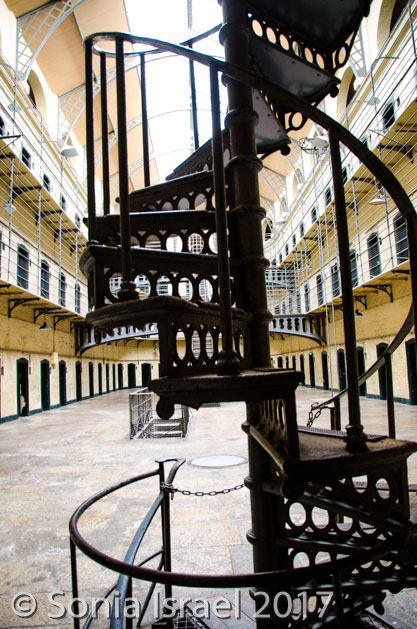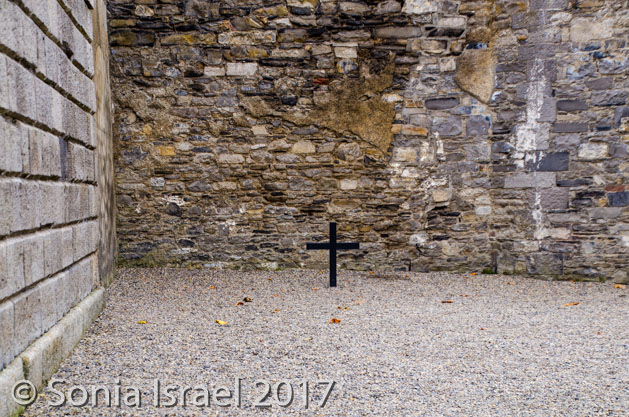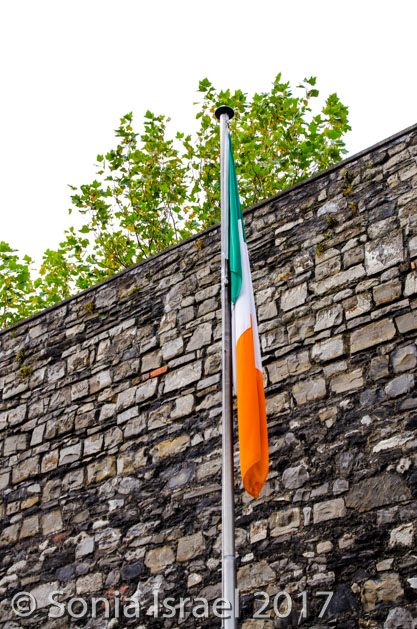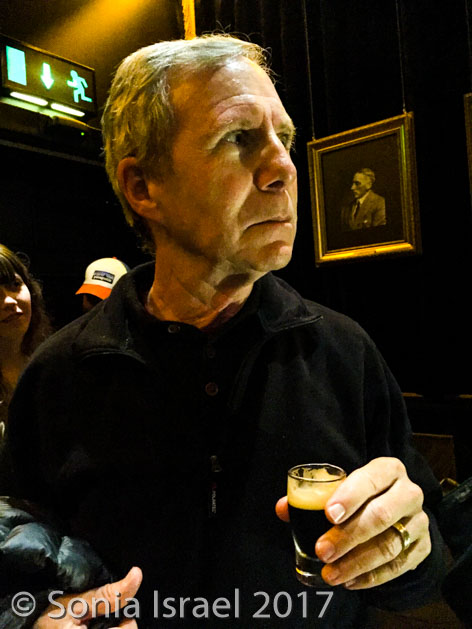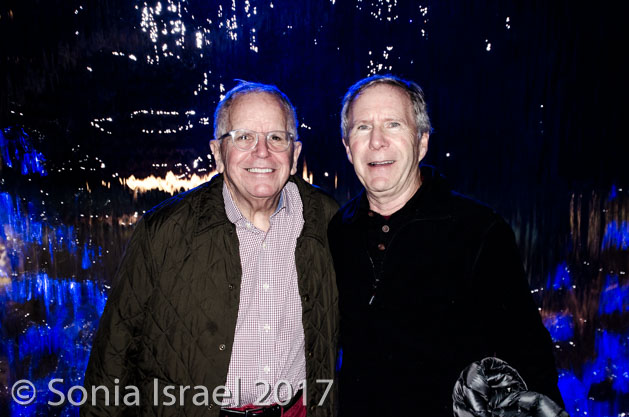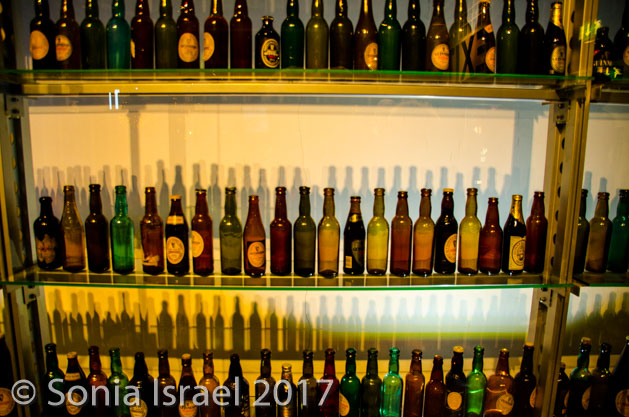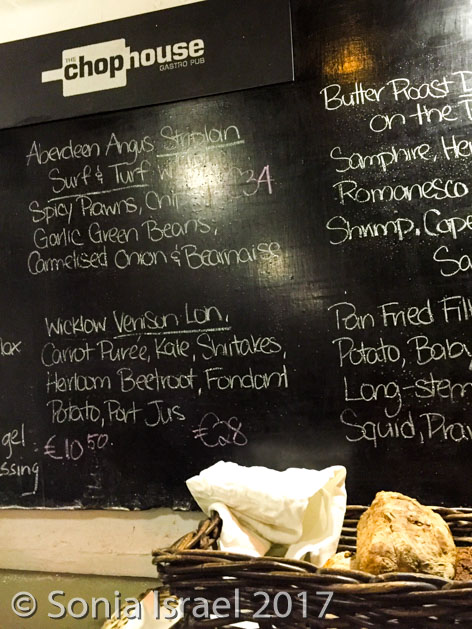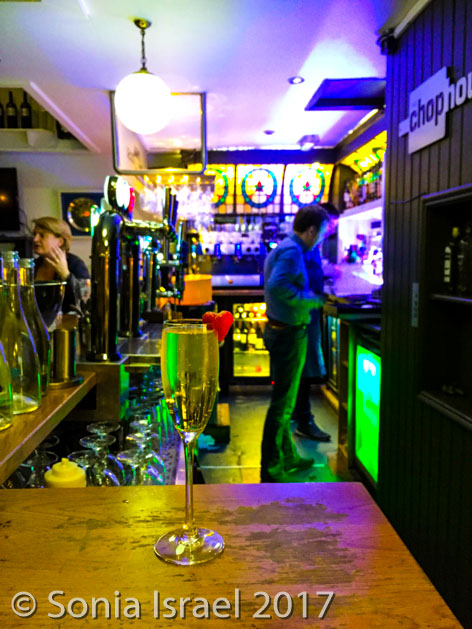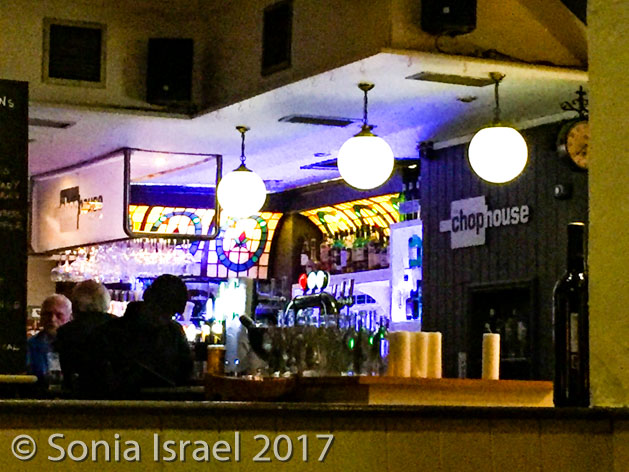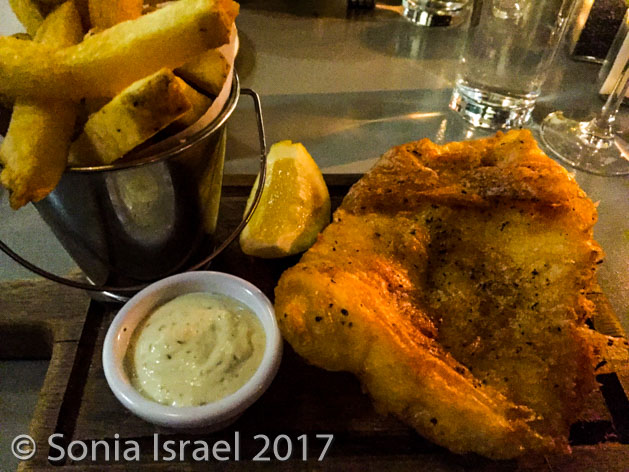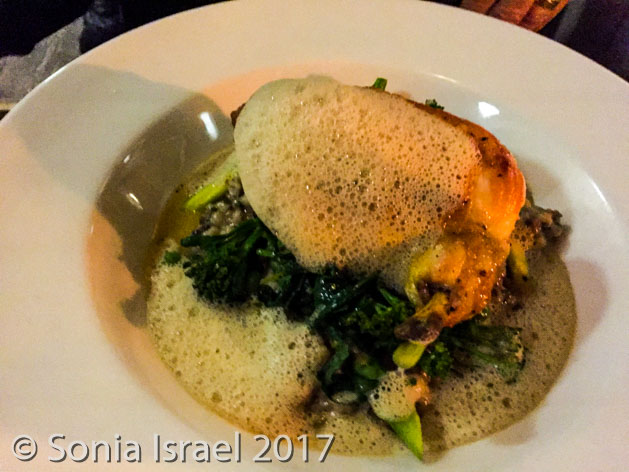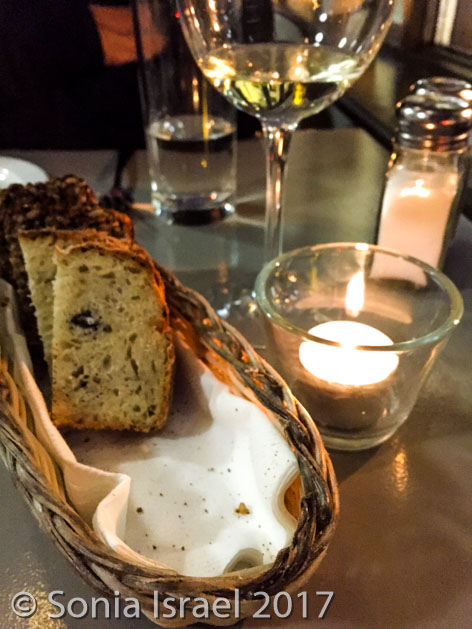Day 3, Friday, Oct 21, 2016
Work – well that is, after all, why I’m here
This morning was my symposium, so it was back to the Aviva stadium. What an unusual place to have a meeting and to give a talk. The view from the wall-to-wall windows was onto the very green soccer field. Although the room was set up with rows and rows of chairs, it was clearly a small ballroom, with built-in bars. Let’s face it, most people come hear to drink beer, not hear talks.
But the talks went well and my colleagues and I were very pleased.
But all this work meant we didn’t get to tour until the afternoon. We had reserved tickets both to see Kilmainham Gaol (Jail) and the Guinness Storehouse. [Note: always get your tickets on-line well in advance as they sell out). Our tickets for the Kilmainham Gaol were for 2:30. Since we got there early, we took a walk around the gardens of the old hospital across the street, which is now an art museum. With more time, it would have been great to also see the museum.
Kilmainham Gaol
When it was our turn, we were sent into the holding cells to begin our tour. Kilmainham Gaol opened in 1776 and was closed in 1924. But in between, it saw hundreds of prisoners, both petty and political. It symbolizes the tradition of militant nationalism, particularly from 1916 and from the Irish Civil War of 1922-23. It was the British troops who ran the prison and who hung or shot the prisoners.
There was no segregation of prisoners; men, women and children were jailed up to 5 in each cell, with only a single candle for light and heat. Most of their time was spent in the cold and the dark, and each candle had to last for two weeks. Children were sometimes arrested for petty theft, the youngest said to be a seven-year-old child.
But then conditions changed and each prisoner was given his or her own cell. In 1862 they moved prisoners from their small, dark cells, to a newer, brighter area with a large central hall where the sun poured in from skylights above. There was a placard that explained: “The building has…the one great fault of all old prisons, where gloom and the exclusion of the rays of the sun were associated with punishment, in ifnorance of the fact now recognized, that the direct rays of the sun exercise an important influence on the physical state of man, his mental diseases and criminal impulses…The Board of Superintendence has given directions to have a large window put up at the end of the prison, to remedy, as far as possible, the gloom of the prison.” All I can say is “YES!” Why isn’t everyone that wise now, recognizing the importance of light!
It is the occurrences of 1916 however, that make this gaol so special. So, what happened in 1916, 100 years ago? The Easter Rebellion. This was an armed insurrection during Easter week, April 1916 launched by Irish republicans to try to end British rule in Ireland, with the hope of forming an independent Irish Republic. It lasted six days. It was led by members of the Irish Volunteers (as opposed to a real army) and they were led by Patrick Pearse, Joseph Plunkett and James Connolly. They seized key locations in Dublin and proclaimed an Irish Republic. The British Army brought in thousands of reinforcements, artillery and gunboats. The fighting was fierce in the streets. Six days later it was over and the leaders were put into the Gaol. Over 3000 people were killed and the Irish were not sympathetic to the rebellious group. But then they began hearing about the executions in the Gaol and suddenly sentiment changed. This was the start of the Irish desire for independence.
Here is one of the stories. Two of those rebelling against the British were Joseph Plunkett and Grace Gifford. The two were married in the jail, given ten minutes (but never alone) and then he was executed. Here is the story in Grace’s words: “I was never left alone with him, even after the marriage ceremony. I was brought in and was put in front of the altar, and he was brought down the steps and the cuffs were takne off him. And the chaplain went on with the ceremony. Then the cuffs were put on him again. I was not alone with him, not for a minute. I had no private conversation with him at all. There was a guard there and you could not talk. I just had a few minutes to get married and then again a few minutes to say good-bye that night, and a man stood there with his watch in his hand and said, ‘ten minutes.’”
Here is another story, of John Connolly. Although born in Ireland, his family moved to Scotland and at age 14 he lied about his age and joined the British Army. He came back to Ireland as part of the British Army. But he became involved in the politics of Ireland and founded the Irish Socialist Party and was also one of the leaders of the Easter Rebellion. Remember, I spoke about his statue outside the Customs House. As a leader of the Easter Rebellion he was sentenced to death by firing squad. Connolly had been so badly injured from the fighting (a doctor had already said he had no more than a day or two to live, but the execution order was still given) that he was unable to stand before the firing squad. He was carried to a prison courtyard on a stretcher. Instead of being marched to the same spot where the others had been executed, at the far end of the execution yard, he was tied to a chair and then shot.
It was these executions of the rebel leaders that deeply angered the majority of the Irish population, most of whom previously had shown no support during the rebellion. It was Connolly’s execution that caused the most controversy. Historians have pointed to the manner of execution of Connolly and the other rebels that ended up causing public awareness of the rebels’ goals and thus support grew for the movement that they had died fighting for. These stories then changed the hearts of the Irish and the revolution was born.
As we walked through the Gaol, we saw the original cells, tiny and dark. We saw the newer cells that surrounded a large courtyard with a glass roof letting in the light. Over the years, things certainly changed. But it was still a horrible prison. We saw the cell that held Grace Plunkett and the painting she made of Mary. Once released from prison, Grace Plunkett decided to devote herself through her art to the promotion of Sinn Fein policies and resumed her commercial work to earn a living. She was elected to the Sinn Féin executive in 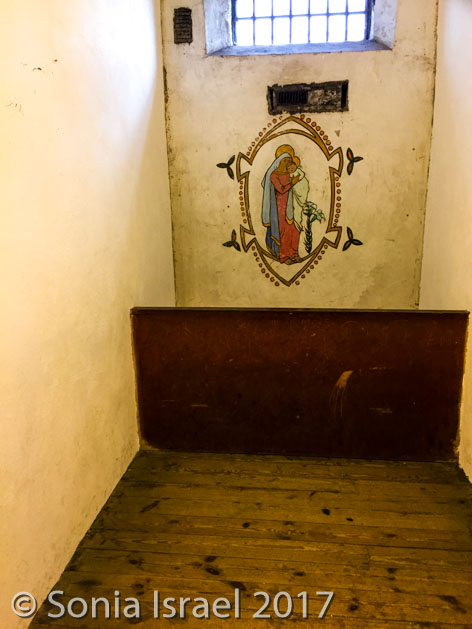 1917.
1917.
In the beginning the hangings of the political prisoners and others took place in front of the prison, with large crowds coming to watch. But in the 1820’s, executions and hangings were moved inside and were done in secret.
Kilmainham Gaol is now considered one of the most important Irish monuments as it is part of the narrative for the struggle of the Irish for independence. And more recently it has also been used as a movie set, including for the movie The Italian Job (which I loved).
It was time to get a little lighter entertainment after the seriousness of Kilmainham Goal. From there we walked about 15 minutes to the Guinness Storehouse. The first thing you see is a view all the beer tanks right next-door to a church. Reminded me of the story of the pub at Christ Church Cathedral. As I said, the Irish love both their religion and their beer.
It was a Friday after noon, and although we had our tickets in hand, there was no line to get in. Guinness storehouse is a seven story museum about how the beer is
noon, and although we had our tickets in hand, there was no line to get in. Guinness storehouse is a seven story museum about how the beer is 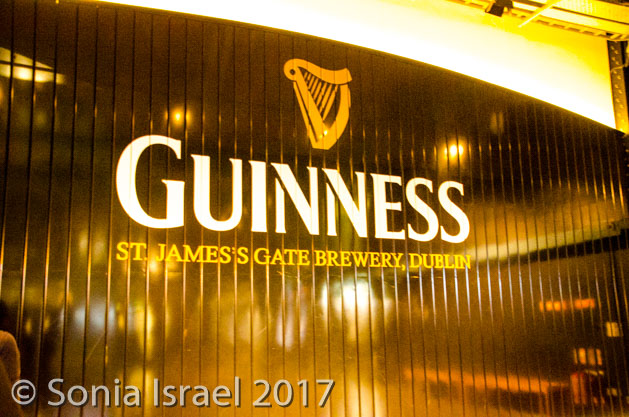 made. Sort of like a Disneyland for beer. There were waterfalls lit in blue. There were videos showing the making of the beer. There were hologram projections of people talking about the history of Guinness. For example, we learned that Arthur Guinness signed a 9000 year lease for the property. And as they say, behind every man succ
made. Sort of like a Disneyland for beer. There were waterfalls lit in blue. There were videos showing the making of the beer. There were hologram projections of people talking about the history of Guinness. For example, we learned that Arthur Guinness signed a 9000 year lease for the property. And as they say, behind every man succ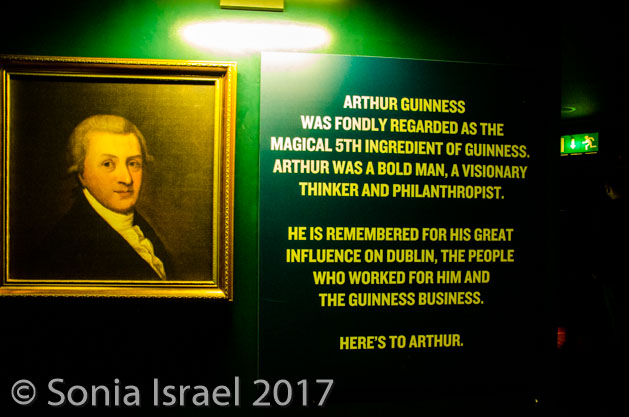 essful man is a great woman. Mrs. Arthur S. had 21 children (YES 21!), 10 of them survived and have carried forward the Guinness legacy.
essful man is a great woman. Mrs. Arthur S. had 21 children (YES 21!), 10 of them survived and have carried forward the Guinness legacy.
There is a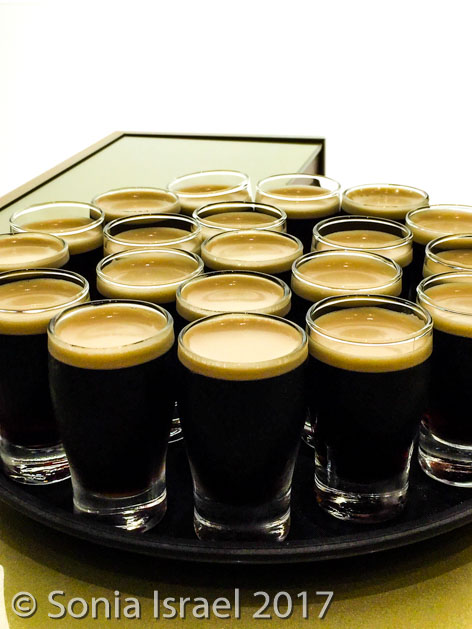 tasting room where they teach you the correct way to drink beer. (Inhale deeply. Exhale. Inhale again tak
tasting room where they teach you the correct way to drink beer. (Inhale deeply. Exhale. Inhale again tak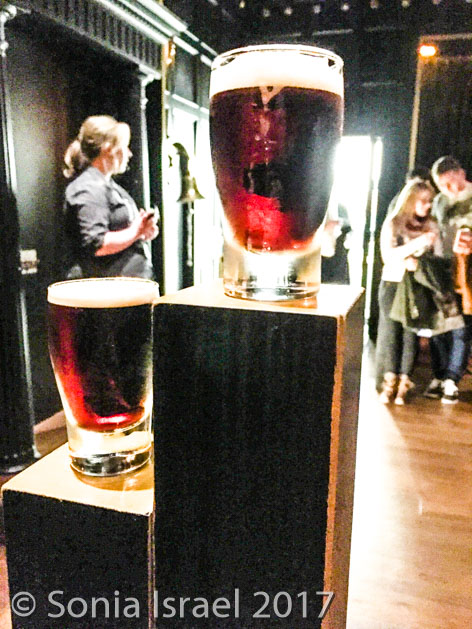 e a drink of beer as your exhaling. That way you get the sweetness of the malt at the front of your tongue and slight bitterness as the beer goes down.
e a drink of beer as your exhaling. That way you get the sweetness of the malt at the front of your tongue and slight bitterness as the beer goes down.
We were really looking forward to the seventh level where there is a 360° view of Dublin. Unfortunately the bar there was so packed with people that we could barely walk around  and barely get to the windows to see the view. Perhaps Friday afternoon was not the best time to visit as everyone else was there with their free pint of Guinness.
and barely get to the windows to see the view. Perhaps Friday afternoon was not the best time to visit as everyone else was there with their free pint of Guinness.
From there we took a taxi back to the hotel as it would’ve been a long walk and after all the walking we had done today, we were tired. We rested for a bit and then went out to dinner. There were just a few choices in the neighborhood. There was a pizza restaurant. There was a pub which ordered food from the pizza restaurant, or there was the Chophouse.
We walked into the Chophouse which had a quiet pleasant atmosphere. We were seated at a window overlooking the outside patio. The staff was extremely friendly and our waiter, Lucas, gave us excellent service. When he had our drink orders and had served us our wine and beer, he brought over a wooden board with the different cuts of meat, explaining each in detail. It was a hard choice, but I ended up with fish and chips and Andy with chicken. My fish was the largest I had ever seen in a fish and chips dish, and was delicious. Andy reported the chicken was the best he had ever had (and we eat a lot of chicken). The dessert menu looked great, but we were defeated by the large portions of our main courses (and maybe the bread…which was fabulous). Just goes to show that you don’t have to have steak at a chop house.
